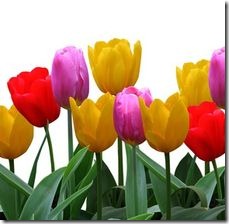The tulip flower grows in a variety of vibrant colors, shapes and sizes and is widely recognized throughout the world. The tulip’s popularity dates back to the 17th century. According to the website springvalleys.com, tulips are the third most popular flower worldwide, ranking next to the rose and chrysanthemum. Billions of tulips are cultivated every year. Most of them are grown and exported from Holland. There are about 100 species of tulips.
Origin
-
Tulips are native to Central Asia. After growing wildly across China to Mongolia, they eventually spread to Europe. By the year 1000 A.D., Turkey had begun cultivating the flowers, which have long played a significant role in Turkish art and culture.
The reign of Sultan Ahmed III, from 1718 to 1730, was called the "Tulip Era," recognized as an era of peace and happiness. Consequently, tulips became part of Turkish daily life, as well as the arts and folklore. Tulip designs and shapes, for example, were incorporated into various Turkish textiles and embroidery. The botanical name for tulip is "Tulipa," which is derived from the Turkish term "tulbend," also known as turban—a Turkish hat shaped like a tulip.
Features
-
Tulips bloom on large bulbous perennial plants, growing bold and showy flowers with six petals. The tulip’s color varies widely and includes: pink, yellow, white, red, violet, green, orange and blue. Its height ranges from 8 to 12 inches, with oblong or blade-shaped leaves that are waxy and fleshy to the touch.
Symbolism
-
The general meaning of the tulip, according to the website springvalleys.com is perfect love. Like many types of flowers, however, each color of a tulip conveys its own meaning. Red tulips, for example, symbolize true love, while purple tulips are associated with royalty. Yellow tulips once meant hopeless love but now represent cheerful thoughts. White tulips are used to send a message of forgiveness, as well as to claim worthiness. Tulip flowers that have different colored petals in various patterns signify "beautiful eyes."
Planting
-
Select your ideal location for planting tulips and prepare the soil by eliminating rocks and weeds. Combine plenty of fertilizer with organic material. Special bulb formulas and bone meal are ideal. Although tulips grow in several types of soil, ensure that your soil has proper drainage. Buy the finest quality bulbs: the larger the bulb, the larger the bloom. Plant bulbs six to eight inches apart at a depth twice the diameter of the bulb in an area that receives direct sunlight.
Maintenance
-
Although a tulip loses its outer parts after its blooming season, it still manages to conserve its underground bulbs. To allow for propagation of future tulip growth, cut the flowers within three weeks after blooming and leave the leaves and stems to dry. Wait a month and a half after cutting the flowers and extract the bulbs. Conserve them in a cool and dry environment until the next planting.


Deprecated: strpos(): Passing null to parameter #1 ($haystack) of type string is deprecated in /home/agriviek8Qv/agriviet.net/public_html/wp-includes/comment-template.php on line 2522